|
|
Post by codystarbuck on Dec 21, 2019 21:23:49 GMT -5
Brave and the Bold #181 Creative Team: Creative Team: Alan brennert-writer, Jim Aparo-artist, Adrienne Roy-colors, Dick Giordano-edits Synopsis: Batman is working on a drug case, as his target is turning over the business to his son. He goes to find his target and finds the gathering interrupted by Hawk, who makes a mess of things. His kick sends the junior drug lord over the side of a building. While Batman bawls him out, he reverts to Hank Hall, kicks Batman low and runs away. However, some of the hoods saw him and Bats knows he needs to find Hank and fast. Meanwhile, Brother Don Hall has been laid off from his government job, in a welfare branch. As he leaves, he witnesses a mugging and changes into costume, though the muggers wonder what kind of name Dove is, for a superhero.... 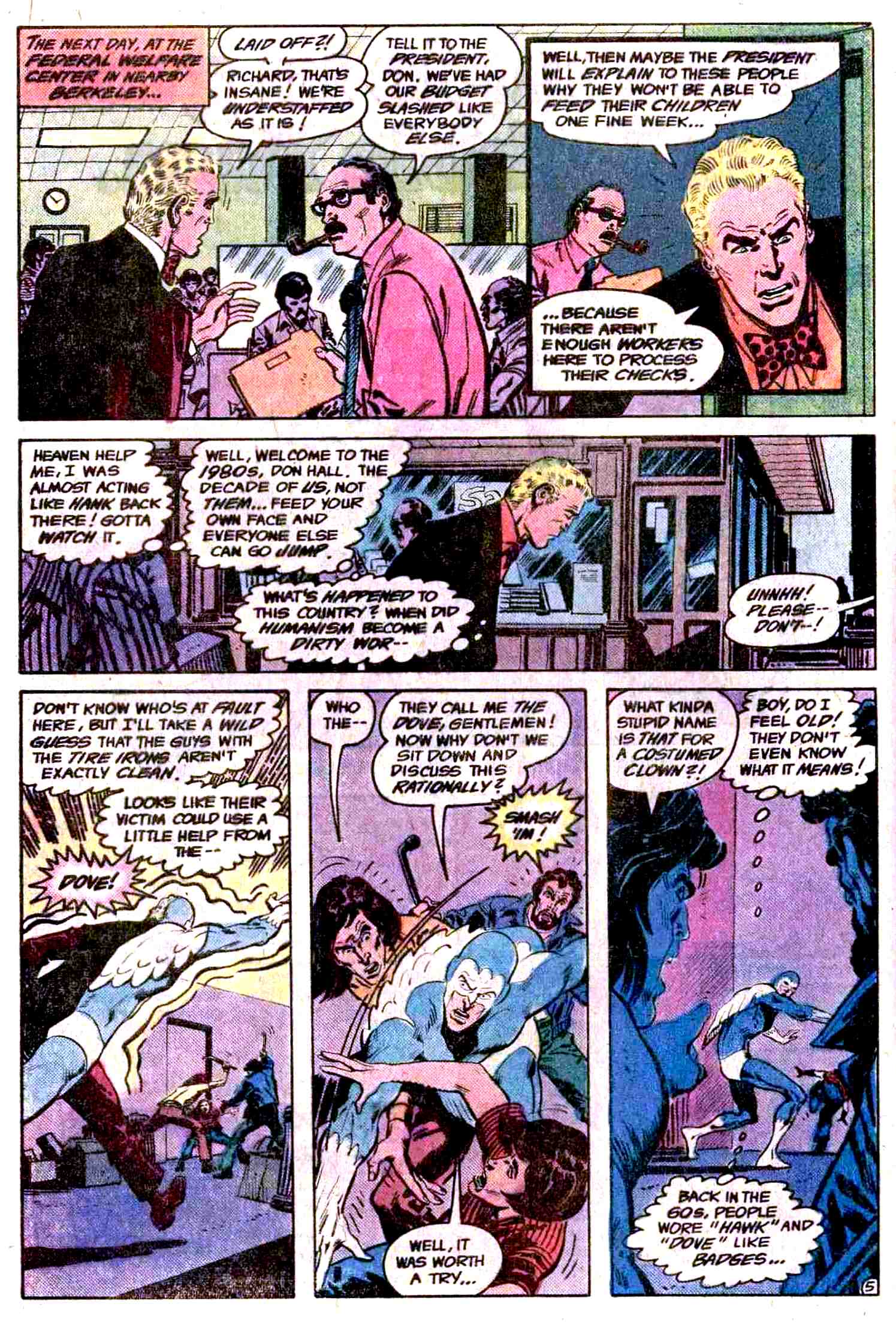 While Hank's fighting style is aggressive "hard" martial arts, Don emplots "soft" arts, like judo and aikido, letting his opponent do the work. he goes home and we see how he is stuck in the 60s, with posters of John Lennon and peace signs, spouting about "bourgeois snobbery," which drives his girlfriend away. he obsesses about Hank and his girl says that he is like half a person. Meanwhile, the mob boss wants Hank dead, for the death of his son. He doesn't know his name; but, they know what Hank looks like. They go hunting. Hank is in his suburban condo, with his wife and his rising debt. She berates him for his spending, his job he hates and their loveless marriage and is leaving him. Hank starts to raise his hand to her and catches himself, horrified. He has been taking his anger out on crooks and he goes to do just that. Batman tracks Don Hall and finds him, hoping to get to Hank before the mob does. He explains his detective work (old fashioned research, with phone books, libraries and computers, for you youngin's). They track down the hotel where Linda, Hank's wife went and find her tied to a chair, surrounded by goons. It's time to play HwackaHood and Batman is the mallet. Dove helps and a hood goes over a balcony; but, Dove saves him. Linda tells them about the house and says Hank is near a breakdown. They go looking for him. Meanwhile, Hank is busting up one of the mob's clubs, when Hawk grabs a chorus dancer and threatens to beat her, until he gets smacked, from behind. Hank is loaded into a boat. Batman and Dove witness this and pursue, but remain cautious. Hank has a vision of the Higher Voice calling to him, saying he has failed to grow, as has Dove. he removes Hawk & Dove's power, leaving Hank before the mob boss and Dove reverts to Don, while underwater, trying to sneak up on the boat. Hank tells the mob boss it was an accident; but, he caused it, trying to live up to his father. The wiseguy sees his son in Hank and seems to change his mind, when a diversionary explosion goes off. Batman and Don come aboard and whoop gangster and Batman tells the brothers that each have qualities the other is missing and they need to accept those qualities in themselves to be whole. 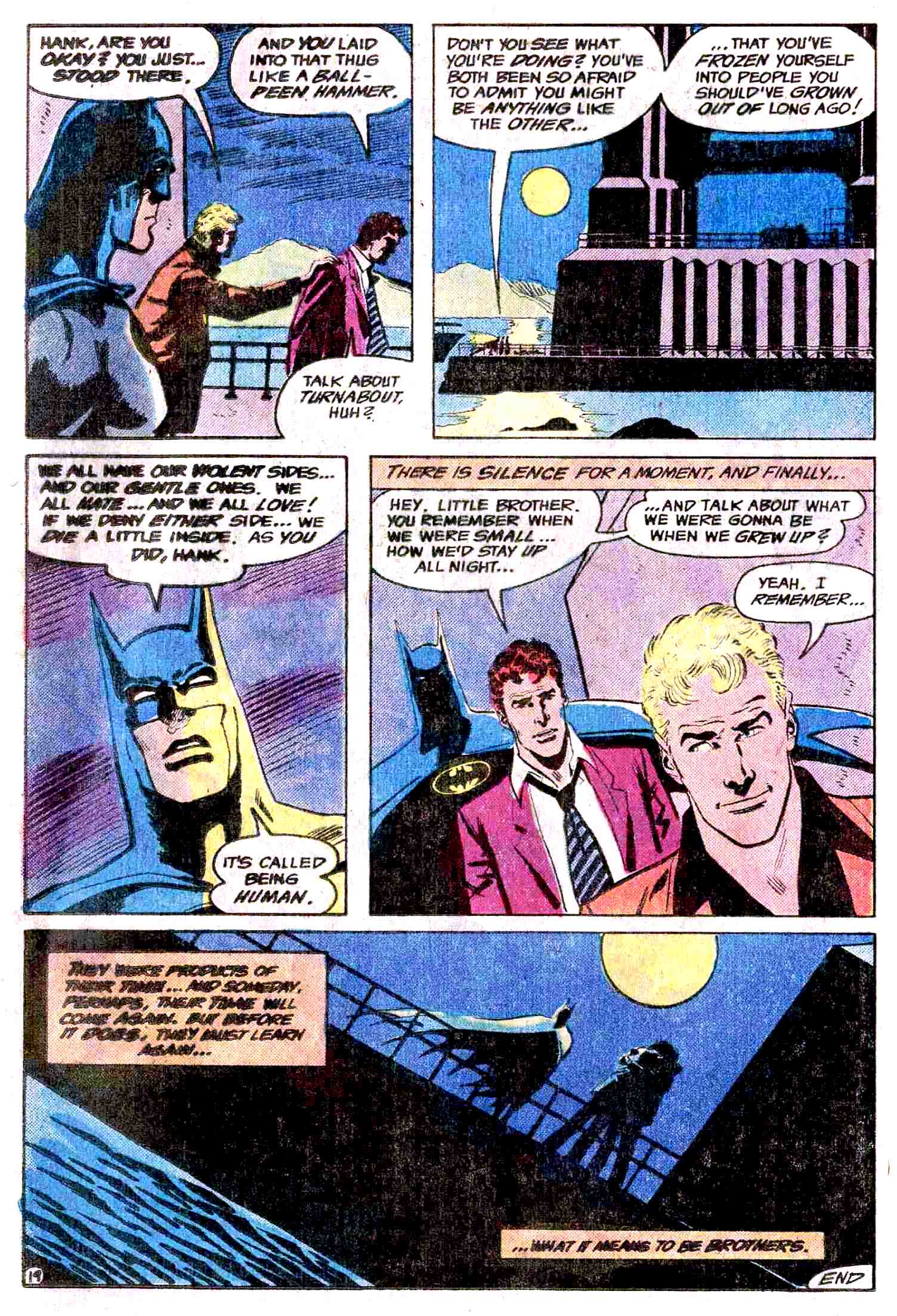 Thoughts: Thoughts: Brennert turns to another Ditko creation and addresses both the present of the Reagan Era and the past of the 60s. Hawk & Dove were created to represent the battle between sides during the 60s, the Hawks and the Doves. the only problem was that Ditko wasn't objective and sided completely with the Hawks. As a result, Dove was a punching bag for Hawk, who always seemed to be right. Also, a passive superhero makes for a boring character. Brennert takes the pair and first gives a bit of backbone to Dove. He represents the idealism of the 60s, where the ideas of youth were going to change the world. They were the people who stood up against a war they felt was unjust, a war that many were forced to fight, via the Draft, and in which they had no say, as they could be drafted at age 18, but couldn't vote. That led the the 26th Amendment to the US Constitution, ratified in 1971, which lowered the voting age to 18 (from 21). Hank represents those who felt that passive resistance accomplished nothing, that direct confrontation was necessary. He also represents those who felt the war was just, to stop the spread of communism, which they felt was a danger to democracy. In the ensuing years, Hank became like many of the 60s generation; a yuppie with a house he couldn't afford, spiralling credit card debt, a job for "The Man," work stress, marital strife, and a loss of purpose. Don became stuck in the past, still trying to help people, through work in civil service, but waiting for someone else to fix things and make it better. Both are lost. Brennert presents the idea that the brothers represent yin and yang, the two halves of the spirit, a very 60s concept, though far more ancient. True harmony comes from a balance between both forces and both have to learn that they must learn to be more like the other, while still retaining the part of themselves that is their core. Hank needs to learn to channel his aggression into more productive ways and work for justice and improvement, while Don has to learn to step up and become more directly involved. He doesn't need to go looking for fights; but, he needs to take more decisive action Both need to learn the Tao, to ebb and flow with the forces of nature and find the equilibrium. Brennert is able to be more objective than Ditko, as neither brother is shown to be superior; both are lost and both have positive and negative qualities. This was the element that Ditko couldn't bring to the characters. In some ways, this story acts as an ending to Hawk and Dove, as they have outgrown their past and must move on to their future. They will next be seen at Wonder Girl's Wedding, in Tales of the Teen Titans #50, before Dove is killed in the Crisis on Infinite Earths. In the post-Crisis world, Dove is still dead and Hank is alone, until a new Dove is Born, as the pair come to represent Order and Chaos, which became the mcguffins in a lot of 80s DC stuff, to the point of boredom, for me. The title of the story, "Time, See What's Become of me..." is a lyric from Simon & Garfunkel's "Hazy Shade of Winter," which would later be covered by the Bangles, for the movie Less Than Zero (loosely based on the novel by Bret Easton Ellis). Time, time time, See what's become of me;
While I look around for my possibilities;
I was so hard to pleas;
But, look around, leaves are brown,
and the sky is a hazy shade of winterThe song (and the film) and the story are about looking back at the idealism and hopes of youth and trying to recapture them, to make oneself whole again, with the wisdom of experience. Much of the 80s was spent refuting the 60s, in many ways, but the pendulum struck to far, in many eyes, and we were left wondering what happened to the ideals; had it all been traded away for easy credit and consumerism? Or was there a middle ground that said you could be successful in your life and make the world better, at the same time? Some people are still trying to answer that question.
|
|
|
|
Post by codystarbuck on Dec 22, 2019 16:23:32 GMT -5
The Brave and the Bold #182 Wait...Batman, Robin and Batwoman? I thought she was dead.........and why does Robin have a different costume? EARTH-2, baby! Wait...the Earth-2 Batman is dead! Creative Team: Alan Brennert-writer, Jim Aparo-artist, Carl Gafford-colors, Dick Giordano-edits Synopsis: A storm rages around Gotham City. At a private observatory, just outside the city, Dick Grayson consults with Ted Knight, who says the storm is man-made and eminates from a point a few miles away. Dick has an idea who is behind it and goes to face him alone; but, Ted pulls out his cosmic rod and suits up and joins him. He flies them out, when a bolt of lightning strikes away the cosmic rod and Ted is out of it. Robin sees the culprit, as he observes the spectral face of Hugo Strange, who has taken the cosmic rod. Meanwhile, on Earth-1, Batman sees his own storm raging. A bolt of lightning strikes near him and he comes to, in a cemetery, with a tombstone that says RIP Bruce Wayne. 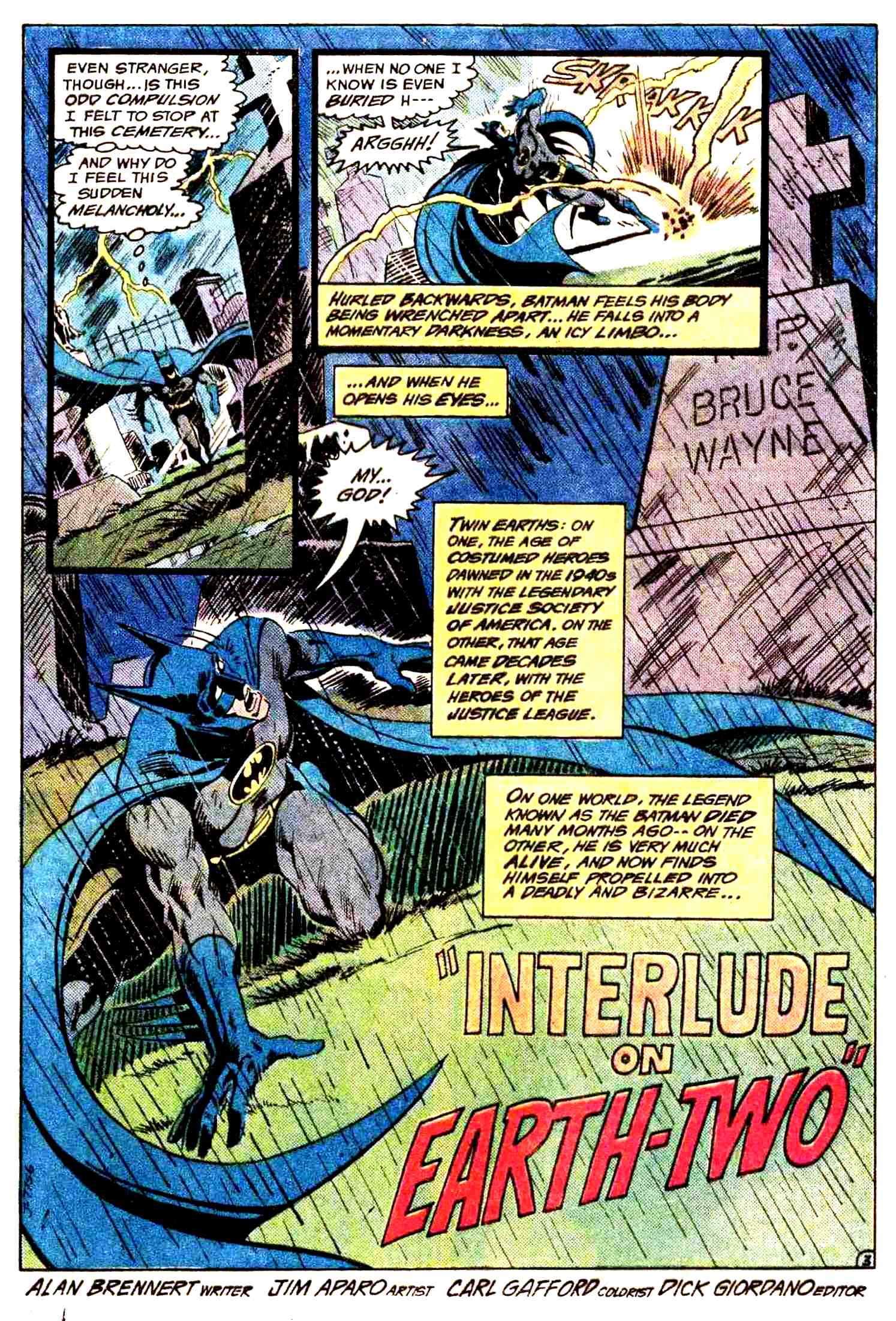 He is confused, until he sees the neighboring tombstone for Selina Wayne. He realizes he is on Earth-2, where Bruce Wayne gave up being Batman and become the police commissioner for Gotham City. He married a reformed Selina Kyle and had a daughter, Helena, who would grow up to become the masked hero, The Huntress. This Batman gave his life to protect Gotham and the JSA from a madman, with supernatural powers. Lightning occurs in balls of fire and Batman finds it odd. In tracing it, he rescues some bystanders, who flee in terror, as Batman is dead. Robin lets us know that Huntress and Power Girl are in Metropolis and Green Lantern has moved to Keystone City, after Jay Garrick got hima job there. The storm has rendered his JSA comunicator useless. he spots a figure trying to pick the lock of JSAHQ. At first he thinks it is Huntress, then realizes it is too tall. He attacks, then sees that it is Batman and thinks, for a moment, it is his adoptive father, until he notices the chest emblem and recognizes him as the Earth-1 Batman, who he met, with the JSA. They go inside and share info. Batman remarks that Hugo Strange died on his world, a year ago (the Englehart/Rogers run of Detective Comics) and Robin relates the apparent death of Hugo on this world, after his monsters. Batman asks Robin to call him Bruce and Dick replies there is only one Bruce to him, and Batman is shocked but understands. They go outside and are attacked by Catwoman's old plane,, destroyed years before. Batman tells Robin to get down and tries to disable it and realizes that Hugo Strange is using the cosmic rod to recreate weapons of old foes (bit of a stretch in logic; but, okay...) He tries to steer it to safety and bails out but misses a pole, forcing Robin to swing in and save him and remind him that he is Batman's age, not a kid sidekick. Batman takes the point when a giant top comes at them, only to be stopped by Batwoman. Batman is taken aback, now, as Kathy Kane has recently perished. Robin introduces Batman to the Earth-2 Batwoman. 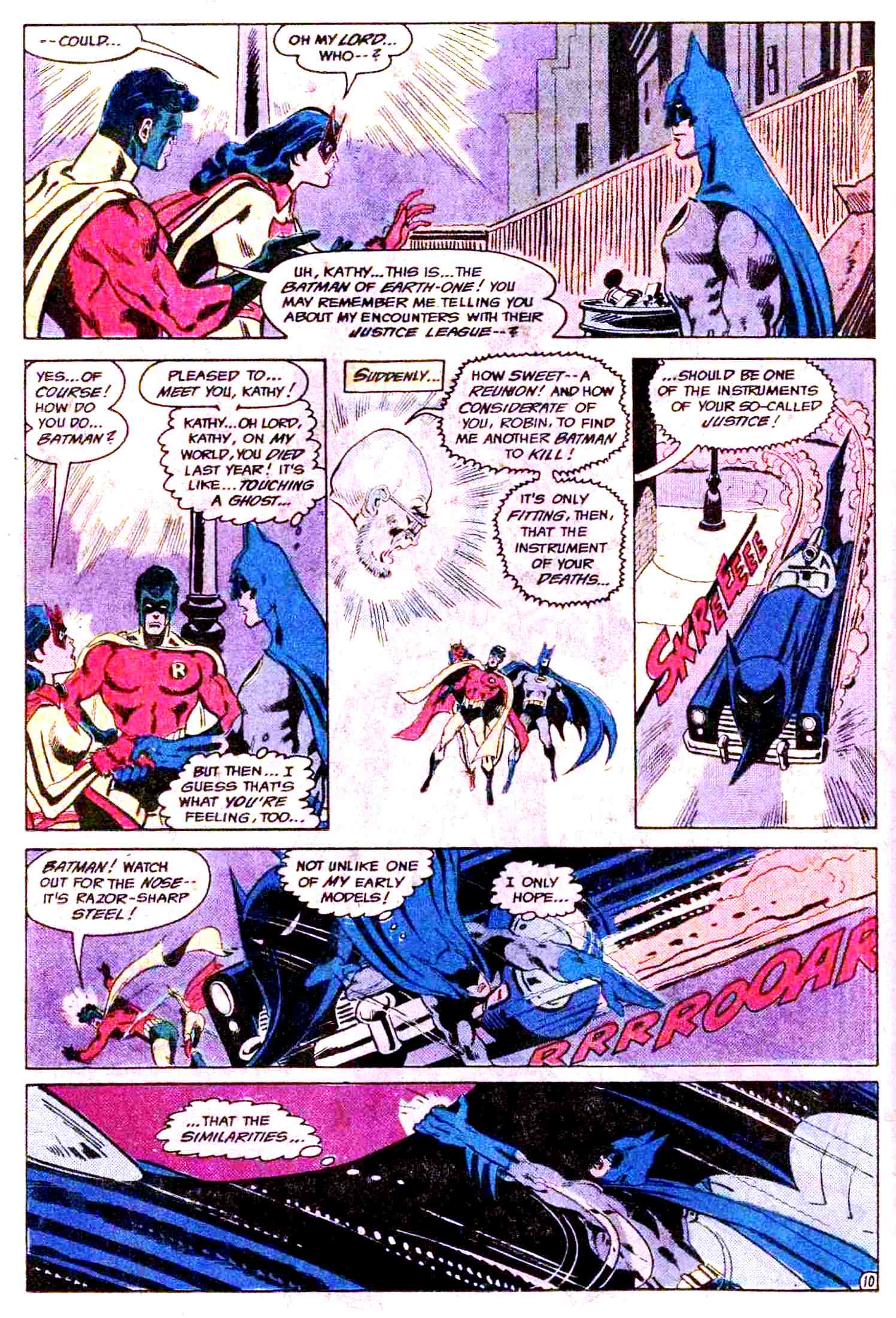 Strange sends the old Batmobile to attack them. Batman yells for Robin to disable it, which he reluctantly does, with a Batarang to a tire. Batman was sure there would be back-up transport and finds Whirlybats in the trunk. Robin tells Batwoman to stay behind, as she has a family and she replies that she loved Batman but wasted precious time and gave up her life when she heard he had gotten married. She has a family of her own; but feels she must help save his city. Batman examines the wreckage and finds that the Batmobile bumper has a year etched on it and Robin realizes he did that, when they retired it for a new model, in 1955. Batman deduces that it was the real deal and the place to go is the Batcave. The go inside, after Batwoman is blindfolded (some things never change) and Batman says Strange will be waiting for them. Robin testily replies, "No s@#$, Sherlock" and Bats tells him to get over it, as they need to work together. Strange attacks with more of the trophies, including the giant dinosaur. Bats orders Robin to get a Penguin flamethrower umbrella from a trophy case and he and Batwoman go up to oosen stalactites and smoosh the dinosaur, after Robin drives it into position. They congratulate themselves as Strange attacks with a Batman robot. Robin and Batwoman hesitate and Bats must save them... 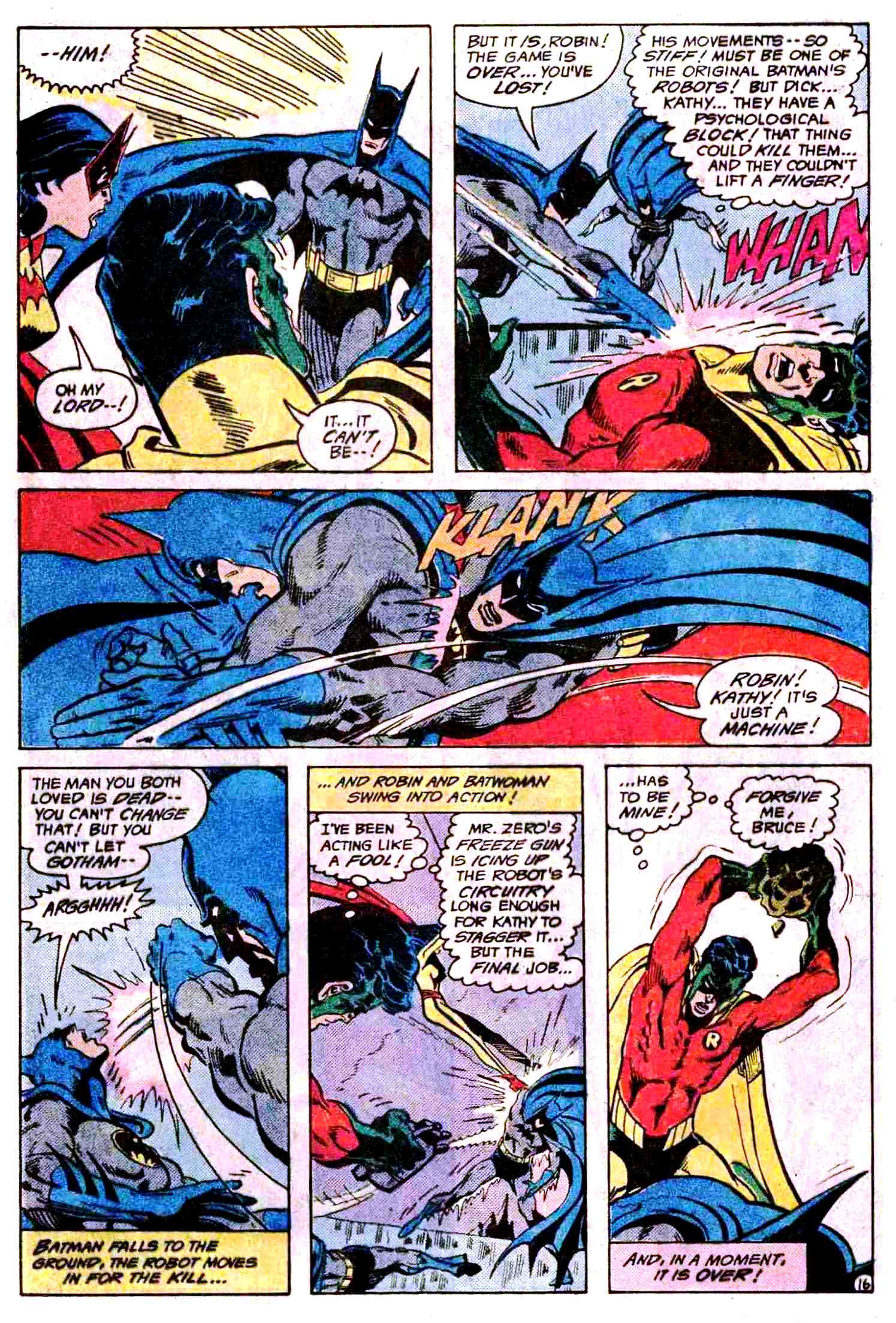 He gets clocked and Robin has to save him, by smashing the image of his father with a rock. Finally, out shambles a crippled Hugo Strange, holding the cosmic rod and ranting about what happened to him. 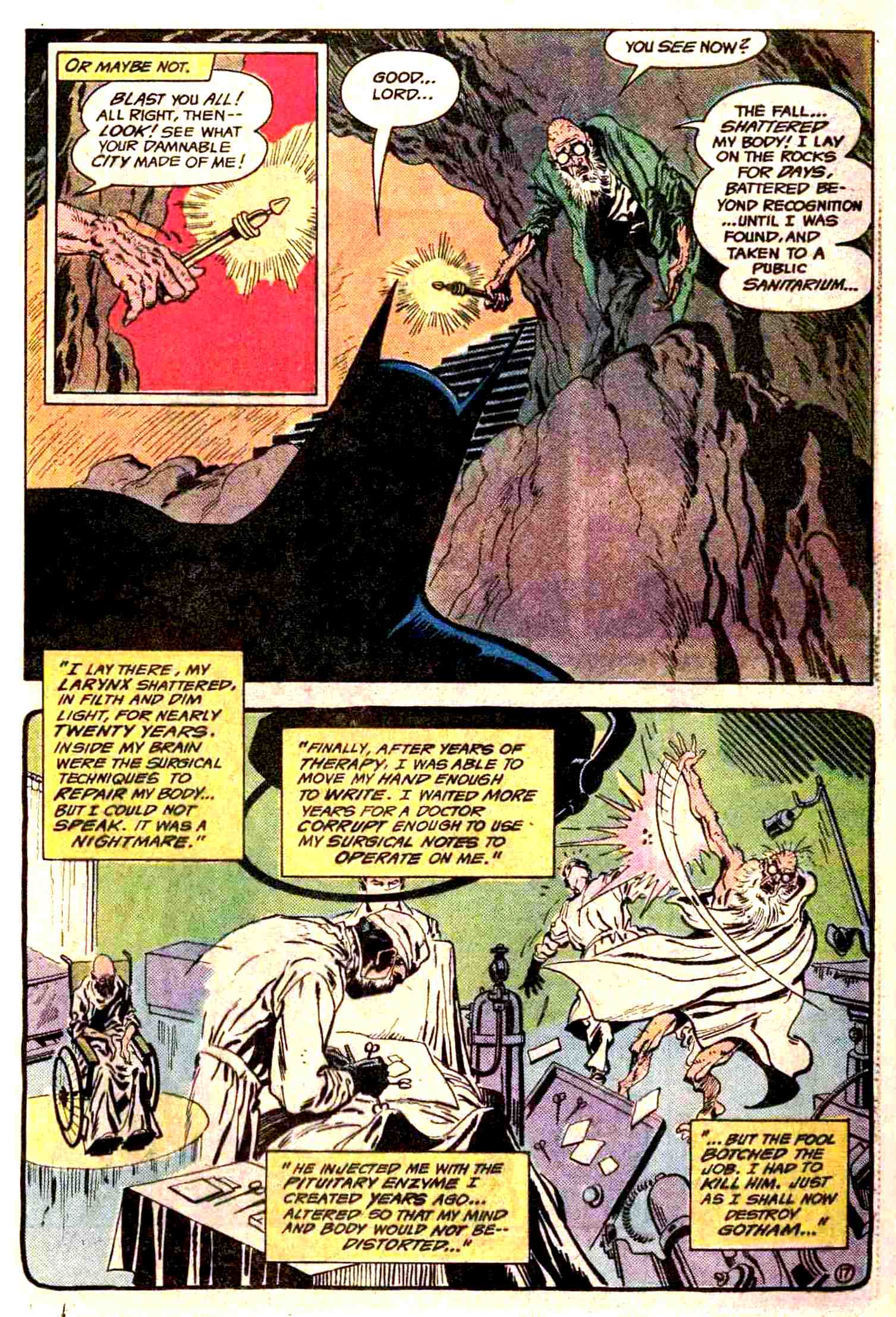 Bats realizes that Strange has brought them together to commit suicide by superhero, since he can't kill himself. He goes to stop him and Strange turns the cosmic rod on himself and turns himself into ashes. The group says their goodbyes and Batwoman thanks Bats for reminding her of the good times. Batman kisses her and thanks her for reminding him how much he cared about another woman, like her (his Kathy). Robin apologizes for being so rude, that he was still mourning the loss of his father. Starman uses the cosmic rod to send Bats back and asks Robin about the rod bringing Batman here. he can see the dimensional rift, but can't understand how Batman would be particularly chosen to come through and Robin says it is best not to think about it, as we see a bat shadow, cast by bruce Wayne's tombstone. Thoughts: Here, Brennert again pays fitting tribute to the past. The previous issue, he gave closure and healing to Hawk and Dove, showing how they were two sides of the same coin. Now, he pays tribute to the original Batman, by having his next generation version work with his sidekick and 1950s love interest. He doesn't make it pure nostalgia, as the presence of E1 Batman causes Robin to resent him, as he still grieves for his Batman. Kathy also grieves for him and love unrequited. Batman has trouble recognizing that Robin is more experienced than he is and that this is not the Kathy who was recently murdered by a brainwashed Bronze Tiger, on order of the League of Assassins. Still, it is a vision of a life he could have and reminds him that he does have family and friends. Brennert recognizes that we fans grieve for our favorite characters and that the rush to create surprises within stories sometimes yanks away characters, without letting the fans go through the stages of grief for them. Earth-2 Bruce Wayne was barely re-introduced into All-Star Comics, when he was killed, saving the JSA, in his last case. His daughter became Huntress after the death of her mother, a death which caused Bruce grief, as well. Robin saw his father die, alongside his sister. Both continue life, but haven't had closure. We didn't get much closure. Batman died and was buried, then the next issue, all knowledge of his death was erased, except the fact that he had died, so as to protect the secret that Bruce Wayne had been Batman, and the identities of his children. Kathy Kane was killed as a mcguffin for Batman's battle with the League, caught between Ra's al Ghul and Osensei. She had only recently reappeared, after being retired, then was taken away. Brennert says it is okay to mourn their deaths and find closure, paying tribute to why we loved them. In this, he gives us a glimpse of future work, as he reminds the Powers That Be that their editorial decisions do not change the past and many of us still remember that past. Our loved ones are given eternal life by our memories of them. This is why we pay tribute to our dead, through ceremonies on Veterans Day and Memorial Day, why we put flowers on graves, why we but black ribbons on photos, have wakes, etc. We honor those we love and how they touched our lives and we continue their memory so that they live on with us and with others. These stories show us why Brennert was considered one of the best writers of the revived Twilight Zone and why Harlan Ellison was such a fan. He got into the human psyche and filled his stories with humanity, always a central feature to the original Twilight Zone and the point of all literature, really.
|
|
|
|
Post by chadwilliam on Dec 22, 2019 21:45:39 GMT -5
The death and rebirth of Kathy Kane came up a few weeks back over on Shaxper's excellent Batman Family thread. I'm reposting the following exchange here because of its pertinence to Brave and the Bold 182...
Dec 2, 2019 at 7:46am shaxper said:
Detective Comics #485 (September 1979)
Boy was I excited to see the return of Kathy Kane, the Atom Age Batwoman, who had now appeared twice in this title but had yet to get a reunion with Batman. Well, they are finally reunited:
...for exactly three panels before she is arbitrarily and anticlimactically killed off panel by a bunch of low level martial arts thugs:
As this is the one cliffhanger Levitz has allowed for the issue, we have no idea whether her murder is ever going to get explained satisfactorily. Did it serve any purpose at all? It is certainly implied by Batman that they didn't even know this was Batwoman.
What in the world was the point of this? Was Levitz so concerned with the over-abundance of homeless heroes post-implosion that they had to unceremoniously off this one? Was it O'Neil trying to get the atom age campiness out of the franchise again? Bob Rozakis had been the one to re-introduce her, as it fit his campy, throwback style, and Levitz just demoted him, so maybe that explains this move.
Whatever the case, it's upsetting.
Chad responded:
If it's any consolation, Alan Brennert didn't like Kathy being killed off either and got around O Neil's cavalierly signed death sentence rather nicely by re-introducing her in Brave and the Bold 182's "Interlude on Earth Two" by assuring readers that while The Batwoman of Earth One was dead, the one in all those pre-New Look tales was alive and well. Interestingly, while Batman is taken aback to see Kathy Kane amongst the living, Kathy is taken aback to see Bruce Wayne A-OK since the Earth Two Batman had been killed off in the equally unmemorable Adventure Comics 462 written by Paul Levitz.
I found the following quote from Brennert online regarding his bringing Supergirl back for Christmas with the Superheroes #2 and am posting this here because while Brennert is obviously being asked about a different story, I really think you could substitute "Batwoman" for "Supergirl" without missing a beat as far as his intentions are concerned with "Interlude":
Well, I wrote it ["Should Auld Acquaintance Be Forgot"] for a fan -- me. Supergirl had just been killed off in "Crisis on Infinite Earths," and both as a reader and a writer, I was kind of pissed that she had been retconned out of existence. It seemed to me a repudiation of not just the character and her history, but the work of the writers and artists who had chronicled that history.
So when [then editor] Mark Waid asked me to write an eight-pager for "Christmas With the Superheroes" #2, I told him I wanted to do a Deadman story, then snuck in the ghost of Kara Zor-El at the end -- without even telling Mark what I was going to do. Mark was understandably startled when he first read it, but he loved the story and knew exactly why I had written it.
Incidentally Shaxper, if you haven't yet read Brave and the Bold 182, I urge you to do so. It's one of the finest Batman tales out there and where O Neil is dismissive of Batman and Batwoman, Brennert is respectful and at the top of his game. If nothing else, it will be a better send-off for Kathy Kane than this.
As to who should get the blame for her death, I'd go with O Neil. I mentioned over in your companion thread Batman 300 and up, that Chuck Dixon killed off Mr Freeze simply because O Neil didn't like the villain. Despite the fact that Freeze hadn't made an appearance in about three years when Dixon was given this request, O Neil still felt bothered knowing that the character was out there and felt an urge to do something about it. I think that's what happened here. Certain characters seemed to rankle O Neil regardless of whether or not they were likely to ever appear again and if given the chance, he'd raze them to ground and salt the earth (see also; Superman and Batman's Super-Sons).
Although DC seemed to consider the Batman of Earth 1 as a character who dated no further back than Detective Comics 327 when he got his "New Look" outfit, I believe it was Brennert who confirmed that the Batman of Earth 2's history paralleled that of the character all the way up until 1964 and not, say, 1955/56. I love how much of a historical cornucopia this story is - you get Hugo Strange circa 1940 using Prof. Zero's Silver Age Freeze gun (and The Spinner's top and Catwoman's plane and...); Batman and Robin in their classic Whirley Bats; a 1950's Batman robot resembling his 1940 self; and Batwoman looking very much like she did during the period which inspired Brennert alongside the 1980's Earth 2 Robin.
For whatever reason, DC obviously felt that having two Batmen was surplus to requirements hence the abysmal tale we got from Paul Levitz in which he was killed off. Similarly, O Neil took it upon himself to kill off Kathy Kane in his equally forgettable tale. Major events, yes, but written as if they were filler tales meant to meet a deadline. It says a lot about Brennert that he can do more with the ramifications of these major events than Levitz and O Neil with the events themselves. Additionally, for a tale which is so steeped in death, it feels so strangely sombre and yet fun. The Earth 2 Batman is dead; Robin will never have another partner/father figure like him again; Batwoman is destined for her love for Batman to remain unrequited; The Batman of Earth 1 is fighting for a Gotham which either fears or resents him; and yet how can you not love Whirly Bats and robot Batmen?
One thing I don't quite understand - how does Hugo Strange know that Batman is Bruce Wayne? His Earth 1 counterpart figured it out, but this one just seems to know without anyone wondering where he got that info from. It kind of reminds me of how the Catwoman of Earth 1 just suddenly knew that Batman was Bruce Wayne around the time it was established that her Earth 2 doppleganger had that info. I've long wondered if with regards to Selina Kyle, the writers just confused the two characters, but Brennert doesn't seem like he'd be careless enough to make such a slip.
|
|
|
|
Post by mikelmidnight on Dec 24, 2019 13:03:40 GMT -5
Brennert turns to another Ditko creation and addresses both the present of the Reagan Era and the past of the 60s. Hawk & Dove were created to represent the battle between sides during the 60s, the Hawks and the Doves. the only problem was that Ditko wasn't objective and sided completely with the Hawks. As a result, Dove was a punching bag for Hawk, who always seemed to be right. Also, a passive superhero makes for a boring character. Brennert takes the pair and first gives a bit of backbone to Dove. He represents the idealism of the 60s, where the ideas of youth were going to change the world. They were the people who stood up against a war they felt was unjust, a war that many were forced to fight, via the Draft, and in which they had no say, as they could be drafted at age 18, but couldn't vote. That led the the 26th Amendment to the US Constitution, ratified in 1971, which lowered the voting age to 18 (from 21).
Not all of this can be laid at the foot of Steve Ditko. According to the writer, Steve Skeates, his original scripts were much more balanced, but every time he wrote a scene in which Dove was nonviolently assertive and Hawk hesitant (for example, illegally wiretapping a suspect), the editor Denny O'Neill would rewrite it and flip their actions, the result being that we wound up with Hawk being a slightly-grittier-than-average typical superhero and Dove being completely useless.
I actually find the idea of a pacifist superhero fascinating due to its seemingly oxymoronic nature. In Hawk & Dove, the problem was handled by making Dove passive to the point of incompetence. In Bill Widener's superlative Go-Man, the titular hero handles the problem by using non-punchy methods of subduing his opponents like drugs and hypnotic devices. In Possession, Morningstar handles the problem by cheating and making her partner, El Cadejo, do all the dirty work. 
Order and Chaos was simply a poor fit for Hawk and Dove. The concepts don't match up with each other. One idea that Steve Whitaker and I bandied about was that the mysterious 'voice' might have turned out to be Darkseid, with the brothers inadvertent moles sent to disable the superhero community, but we never found a way to make it work.
|
|
|
|
Post by MDG on Dec 24, 2019 13:22:30 GMT -5
Not all of this can be laid at the foot of Steve Ditko. According to the writer, Steve Skeates, his original scripts were much more balanced, but every time he wrote a scene in which Dove was nonviolently assertive and Hawk hesitant (for example, illegally wiretapping a suspect), the editor Denny O'Neill would rewrite it and flip their actions, the result being that we wound up with Hawk being a slightly-grittier-than-average typical superhero and Dove being completely useless.
I actually find the idea of a pacifist superhero fascinating due to its seemingly oxymoronic nature. ...
In one or two of Byron Priess' Weird Heroes paperbacks, someone (Steve Englehart or Archie Goodwin, maybe) tried to develop a non-violent hero character, but it didn't seem to work. A lot of sneaking around and tying people up. Order and Chaos was simply a poor fit for Hawk and Dove. The concepts don't match up with each other. One idea that Steve Whitaker and I bandied about was that the mysterious 'voice' might have turned out to be Darkseid, with the brothers inadvertent moles sent to disable the superhero community, but we never found a way to make it work.
The constant reliance of Order and Chaos as a plot device was one of the things that drove me away from DC in the early 90s. |
|
|
|
Post by EdoBosnar on Dec 24, 2019 13:55:45 GMT -5
In one or two of Byron Priess' Weird Heroes paperbacks, someone (Steve Englehart or Archie Goodwin, maybe) tried to develop a non-violent hero character, but it didn't seem to work. A lot of sneaking around and tying people up. Preiss' general editorial dictate for the Weird Heroes series was that the protagonists shouldn't depend on punching, shooting or other forms of violence to resolve their problems, but rather depend more on intelligence, ingenuity or cunning. He didn't require entirely non-violent stories or even characters, though. Not really sure which story or stories in Weird Heroes you're referring to; Goodwin's story featured a character called Adam Stalker, a Vietnam vet who works as a PI in Tulsa, while Englehart's was about a character called Viva, a former prostitute and drug addict - who would be what we now call a human trafficking victim if I recall correctly - who becomes a jungle heroine. Both are pretty solid stories, and don't really match your description.
|
|
|
|
Post by codystarbuck on Dec 25, 2019 12:54:31 GMT -5
Brave and the Bold #197 Creative Team: Creative Team: Alan Brennert-writer, Joe Staton-pencils, George Freeman-inks, John Costanza-letters, Adrienne Roy-colors, Len Wein-edits Some background. DC Comics had revived All-Star Comics, featuring the JSA, picking up the numbering from when the comic was retitled All-Star Western. They added a Junior JSA, the Super Squad, to hook newer readers, featuring Robin, the Star-Spangled Kid and Power Girl. Power Girl, of course, was the Earth-2 Supergirl. By the time Paul Levitz came on board, inker Bob Layton put forth the idea of a revamped Earth-2 Batgirl. Instead of reviving Betty Kane, they decided to create a new character. She technically debuted in DC Super-Star #17, which told her origin, and All-Star Comics #69, where you see her meet the JSA (as the Huntress. The DC Super-Stars issue provided the origin. Bruce Wayne had gone into semi-retirement and marries a reformed Selina Kyle, after she leaves prison. Robin takes over as guardian of Gotham City and Bruce and Selina welcome a daughter, Helena, into the family. She grows to maturity and we see Selina receive a mysterious phone call, which comes from an old henchman, Silky Cernak, who has a photo of her killing a man, a secret withheld from Bruce. he threatens to expose her, as Bruce believed she had never committed more than petty thefts, unless she aids him in a robbery. She agrees and the police send up the Bat-Signal when they get word of a crime being planned. Robin is away, so Batman comes out of retirement and tracks down the gang and surprises them. Selina, seeing Batman, is stunned and falls backward, hitting a railing and flipping over the side, plunging to her death. Cernak gets away and Bruce goes into mourning. Helena makes a vow at her mother's grave to avenge her death and takes up the name Huntress, with a costume that pays tribute to both parents. She tracks down and confronts Silky Cernak, and proves her mother's innocence of murder (Cernak doctored his photo evidence). From there, she becomes the Huntress, operating solo and with the JSA.  This tale tells how Bruce and Selina came together. Synopsis: Bruce Wayne is recording his secret memoirs. He has written about becoming Batman, taking Robin in, and working alongside the JSA. Now he turns to the love of his life. It begins with a meeting with Commissioner Gordon, in 1955. As Gordon waits, he sees Batman swing in and gunned down. it turns out to be a hallucination, caused by the Scarecrow, who sent a doll, with a time-released spray of fear gas. Batman goes to investigate. Later, Bruce Wayne is attending the wedding of old girlfriend, Linda Paige. He goes up to see the bride, before the ceremony and wish her well and is consumed with thoughts of what might have been and what happens when Dick goes off to college and Kathy Kane decides to stop being Batwoman? He has little in common with friends and is tired of playing the fop. 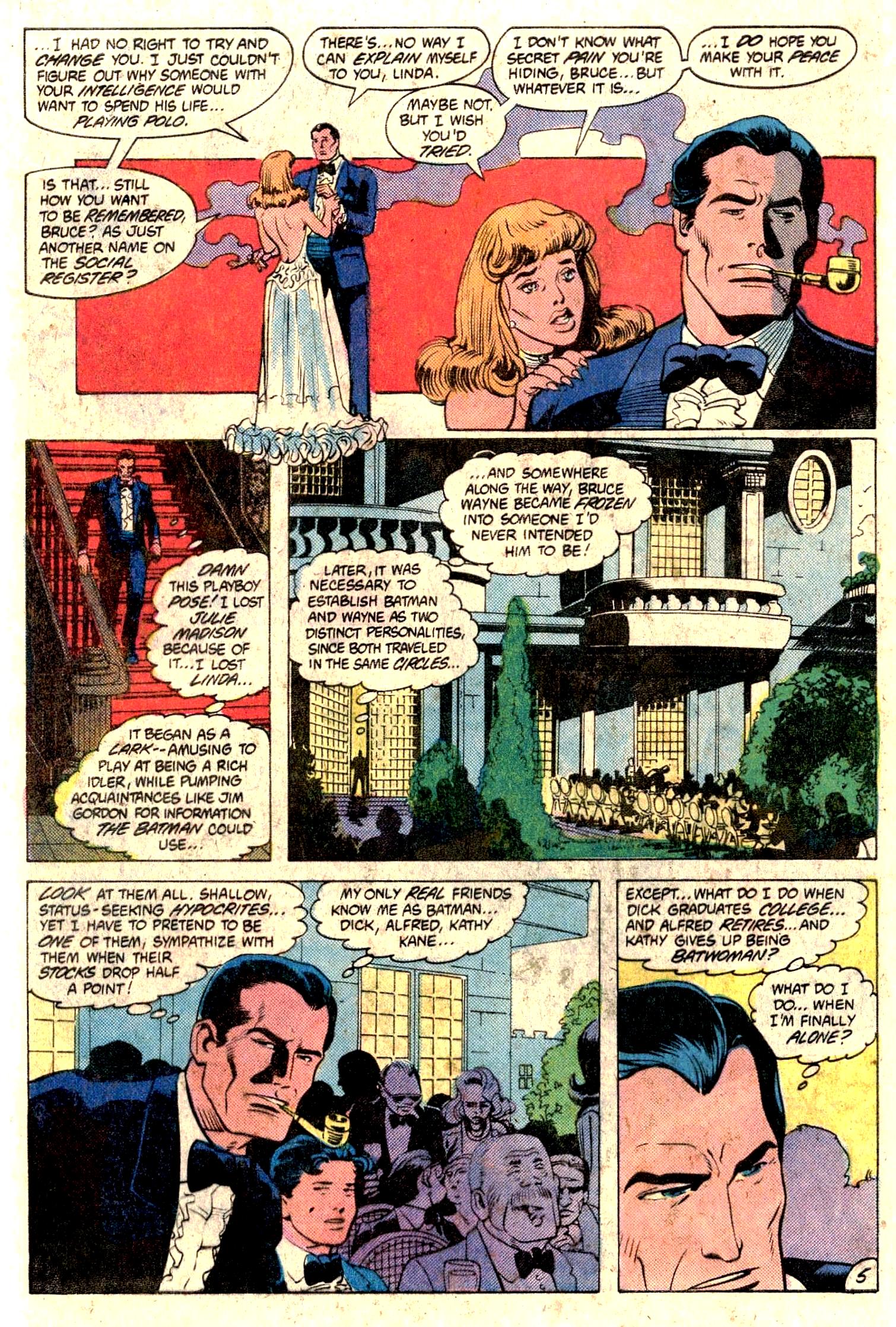 He settles down in his place for the ceremony. Suddenly, everyone starts reacting to hidden terrors. The Scarecrow has attacked and Batman, Robin and Batwoman go into action. Scarecrow drops a fear gas bomb and Batman gets a dose. he sees Robin disappear, then Batwoman and even Linda. His fear is that of being alone. Robin and Batwoman are still there but he can't see or hear them. Batman leaves the scene and returns hme. He tries contacting Superman; but can't hear Lois Kent, on the other end. He gets an inspiration and turns to an old foe, Selina Kyle, aka Catwoman, who is in prison. He asks her to help, and she is reluctant to take up her costume, even for parole. Batman practically breaks down, revealing his inner turmoil to her. She accepts and departs with him. They head to Gotham University, where Jonathan Crane taught. A stone lion "comes to life" and attacks and is subdued by Catwoman. it is a lion, painted white and manipulated through electric shocks, to anger it. Catwoman is angered, as she can't abide cruelty to animals. Batman notices that she appears to be relishing this and wonders if he can trust her. Catwoman feels alive again and they enter Bilfinger hall, to hunt Scarecrow. They find a recording, delivering a lecture and multiple traps. Batman saves Catwoman from a flaming crossbolt, which ignites his cape. Catwoman smothers the flames, then treats Batman's burn, only to see the horrible toll his crusade has taken on his body... 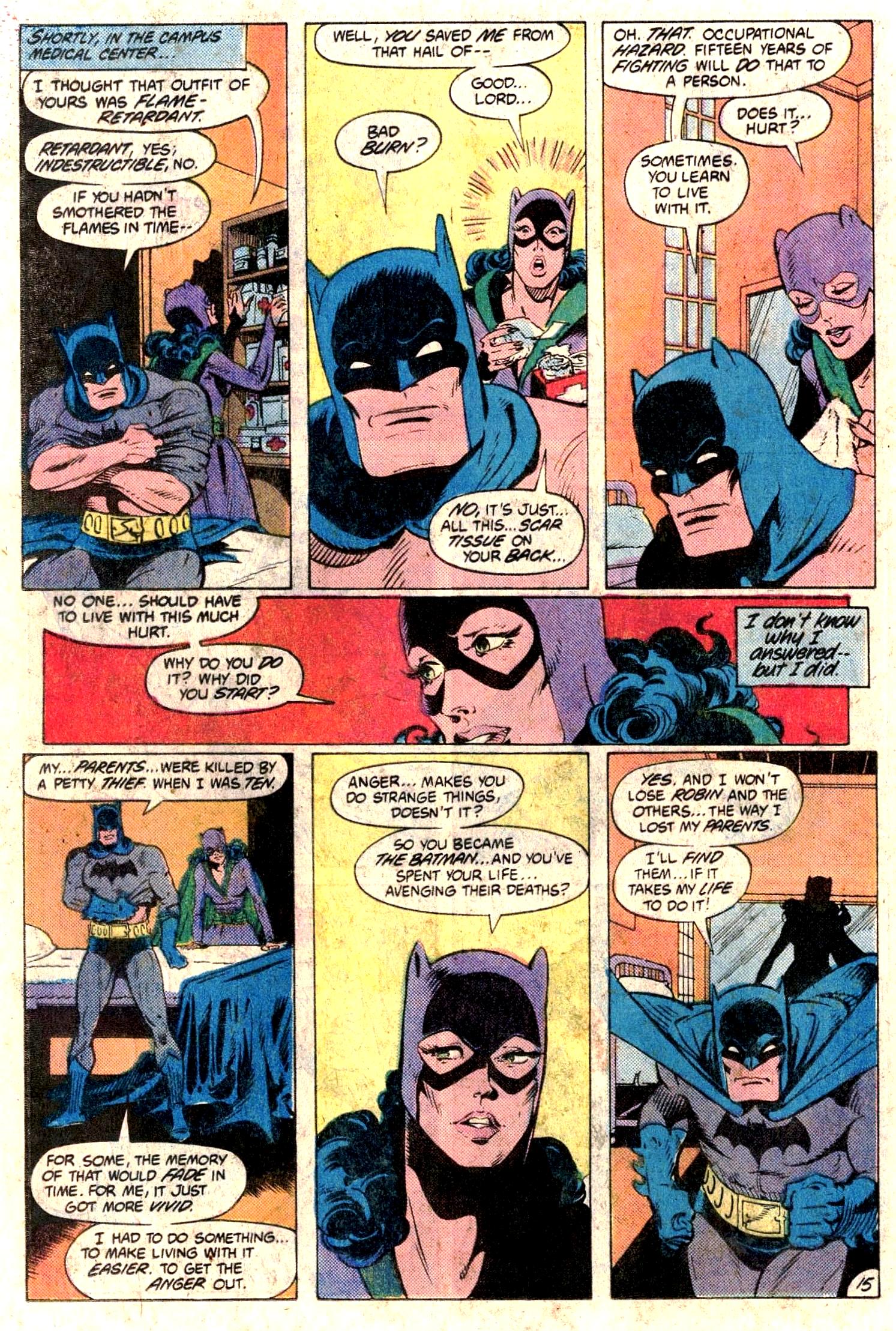 Batman tells of his parent's murder and they move on, as Selina is consumed with empathy for Batman's life. She tries to convince him that Scarecrow's gas has made him believe his friends have disappeared, but he is too deeply affected. Meanwhile, Scarecrow has fired the gas around campus, creating fear pockets. Batman and Catwoman hit one and Seline becomes afraid of heights and nearly falls, as Batman rescues her. They then become afraid of the open space. They rush into the library and Catwoman is angered for being afraid. She lets slip that her past amnesia had been a lie. She tells Batman the truth, that she had been the Cat, a jewel thief, for 2 years, when they met. She had been married to a wealthy man, who physically abused her. She divorced him and tried to financially and emotionally ruin her. She turned to crime as a way to empower herself... 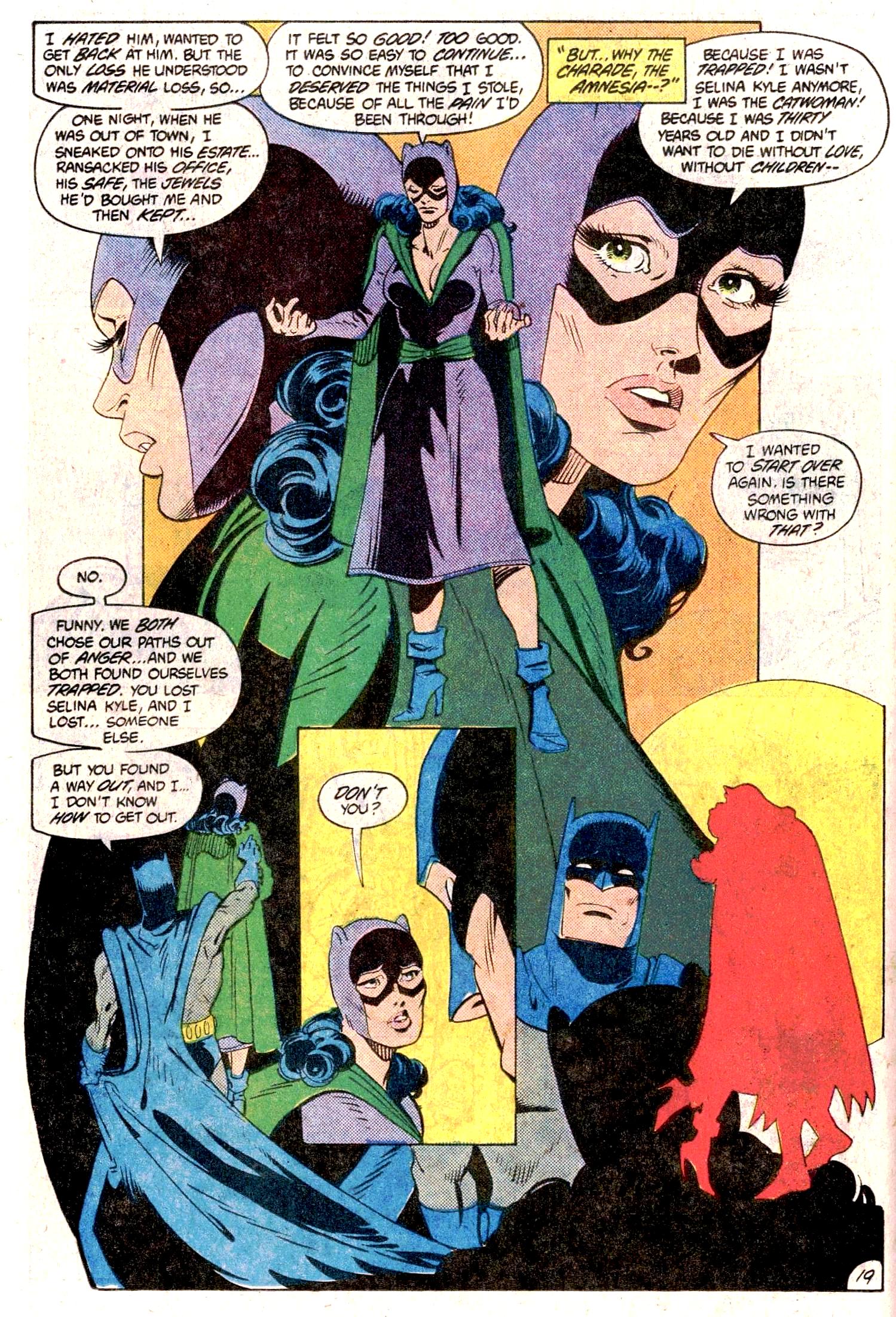 They share a moment of love, then Batman goes after Crane, which turns out to be a decoy. More gas makes him fear cats and he recoils from Selina and she becomes afraid of bats. She appeals to reason and tells him he has created a world of conflict to keep people at a distance, so he can't lose anyone again, like his parents. She takes off her mask to eliminate the cat image and he calms. She tells him to remove her fear of bats... 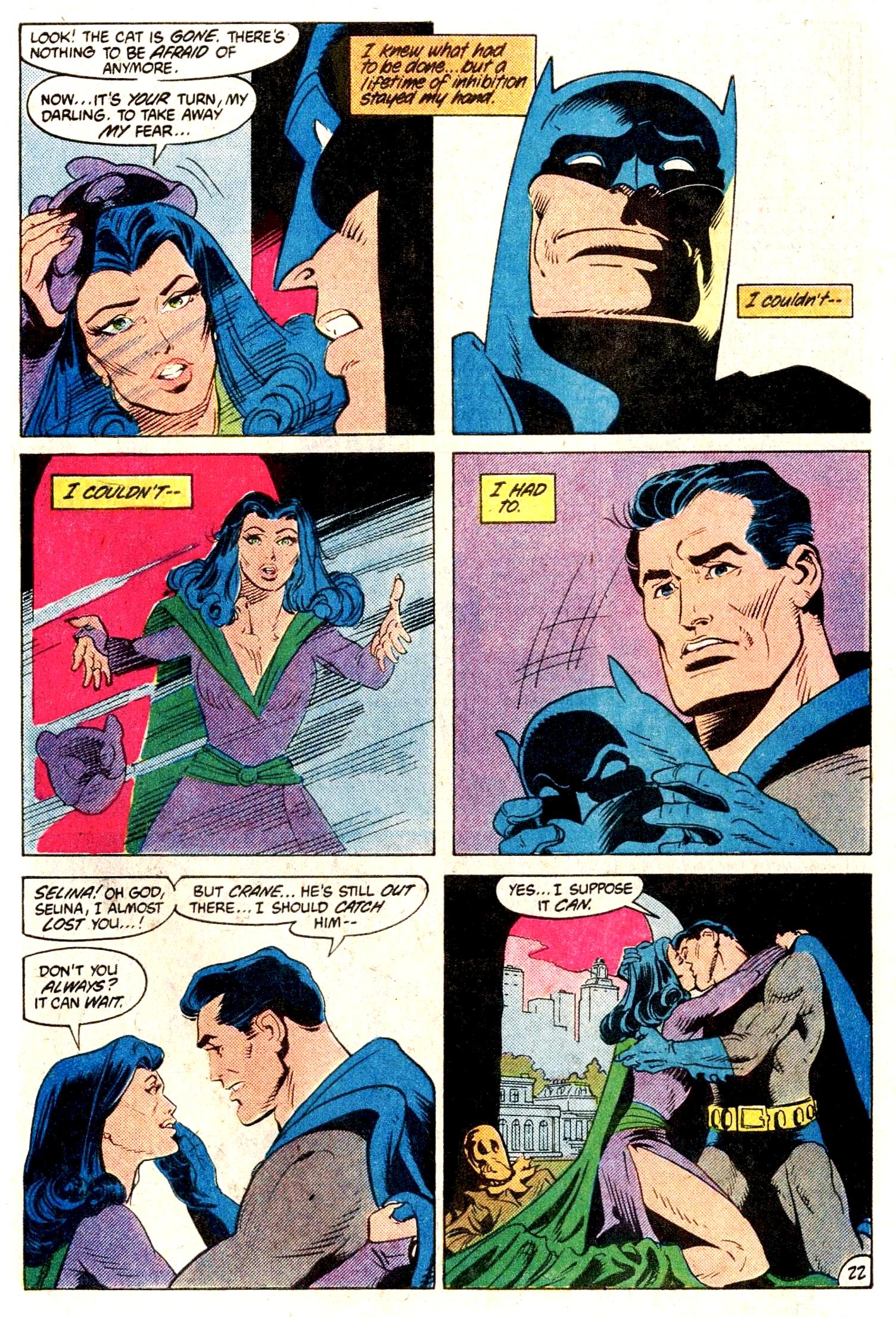 Batman confronts his fear and the spell is broken. They capture Scarecrow and bruce waits for Selina's parole to come through and is there to meet her when she is released. They marry and have a family, as Bruce closes his memoirs. He speaks of her senseless death, which had no meaning. he reflects that she taught him that there is only meaning in life and he will never forget that. Thoughts: Brennert is, ostensibly, telling the story of Batman and Catwoman coming together and eventually marrying. However, he is also getting to the heart of Batman, on multiple levels. The murder of his parents destroyed his life, as he was obsessed about their deaths and gave up any semblance of life for revenge. In doing so, he kept people at bay, so he couldn't be hurt. He was still the little boy, crying out in grief and anger, trying to punch away the hurt. There were cracks in the facade, as he takes in an orphan who shares his tragedy and creates a family, added with friendships with James Gordon and Kathy Kane, not to mention Alfred. he fears losing them and he is seeing that he has no life but the crusade. Scarecrow forces the situation and he must turn to an old foe for help, because he can't see friends. His fear of losing people is overwhelming. Selina has always had an attraction to him, but working with him brings up all kinds of feelings. he is so traumatized that he drops his masks, emotionally and, eventually, physically. She sees the hurt little boy, the lonely man, and she is overwhelmed with her own past of abuse and anger. She gave up a life to strike back at her abusive husband and thrilled to her dances with Batman. She was the one foe who wasn't a murderous psychopath; just a thief with a gimmick. Reason fails and Selina must turn to love, a love which they both finally admit had always been there. It proves more powerful than fear and it gives them life. They spend their lives together and have a family, before Selina is taken away in tragedy. By this point, Bruce was also gone (dying in the pages of Adventure Comics), leaving their children behind to continue. Sadly, they were sacrificed in the name of Crisis, with the Earth-1 Robin surviving and the original lost to the past. Huntress would be reborn as Helena Bertinelli, no longer the daughter of hero and villain. That loss reduced the power of the character and Huntress struggled for a role, for years after. Brennert gives us real mature comics; not violence, sex and profanity; he gives us human beings coming together to share their lives and build a future. Batman and Catwoman leave behind the costumes of youthful fantasy and enter adulthood of home and family, signalling that comics could be more than adolescent power fantasies, despite most of what was on the newsstand, at the time. In many ways, this story sets the tone for what would happen at DC, as their stories became more and more sophisticated and mature, emotionally, even if they didn't fully escape superheroes. However, they did start to indulge more into other types of stories and their line grew in variety, especially compared to Marvel. For a time. Brennert is like a surgeon, coming in to get to the heart of things and then move on, while other writers and artists were general practitioners, dealing with the day to day stuff. Brave and the Bold would end in 3 more issues, culminating in a meeting of Batmen. Brennert was busy with other work; but, he would produce a story for Marvel, which will be our next subject.
|
|
|
|
Post by codystarbuck on Dec 25, 2019 12:59:13 GMT -5
ps Alex Ross would be inspired by the idea of Batman's scarred back to create this image....  Brennert was arguably the first writer or artist to address how damaging Batman's crusade must be, physically, as well as emotionally. |
|
|
|
Post by EdoBosnar on Dec 25, 2019 13:46:15 GMT -5
The matter of the scar tissue on Batman's back is perhaps my only quibble with the otherwise excellent, greatest Batman story ever in B&B 197 (and the later image by Ross just drives the point home): it seems to me that the bulk of the scar tissue and bruises on Batman's body would be on his front torso and face (and one would think his cape would provide a little extra protection for his back). In the illustration by Ross, it looks like most of the bad guys Batman fights are brandishing whips or, hell, steel wire, when in fact he usually gets shot at, or is attacked with blunt objects, or he gets punched or kicked.
|
|
|
|
Post by tarkintino on Dec 25, 2019 15:59:33 GMT -5
Star Trek #12 Creative Team: Creative Team: Alan Brennert-plot, Marty Pasko-script, Luke McDonnell-pencils, Tom Palmer-inks, Joe Rosen-letters, Carl Gafford-colors, Louise Jones (Simonson, eventually)-edits Brennert, et al., really did not do their TOS homework. In the few episodes were Janice Rand appeared, the connection between Kirk and Rand was one of unrequited love (from Janice) to Kirk, who was "married" the Enterprise, as Eve McHuron reminds him in "Mudd's Women" (episode 3) and Kirk himself admits/resigns himself to that fact in "The Naked Time" (episode 6). Further, her dialogue in this issue has her referring to herself as "just a kid--a starry-eyed yeoman"; the Janice seen on TOS was never said to be some younger crew member, not in dialogue, appearance and certainly not in her generally sophisticated behavior with her ship mates. In fact, in what was perhaps her showcase episode, "Charlie X," she deals with 17-year old Charles Evans like a much older sister or aunt--not anyone near the age of a contemporary. To that end, she even introduces him to yeoman third class Tina Lawton, as she was far younger--closer to Charlie's age. Certainly fitting the "kid" description more than Janice. This plot seems like a retread, in that the idea of a human bonding with a non-corporeal being was one of the central plots of TOS' third season episode, "Is There In Truth No Beauty?" between the contained energy of Ambassador Kollos and Dr. Miranda Jones. |
|
|
|
Post by codystarbuck on Dec 25, 2019 18:59:09 GMT -5
The matter of the scar tissue on Batman's back is perhaps my only quibble with the otherwise excellent, greatest Batman story ever in B&B 197 (and the later image by Ross just drives the point home): it seems to me that the bulk of the scar tissue and bruises on Batman's body would be on his front torso and face (and one would think his cape would provide a little extra protection for his back). In the illustration by Ross, it looks like most of the bad guys Batman fights are brandishing whips or, hell, steel wire, when in fact he usually gets shot at, or is attacked with blunt objects, or he gets punched or kicked. In Brenenrt's case (and Staton), I suspect the staging was based on what they could do, under the Code; so, they couldn't really show the scarring, just Catwoman's reaction to it (leading to the staging so Catwoman is looking at his back). Ross remembered the story and depicted it on his back. I think the actual scarring is probably down to what Ross could readily depict, either due to lack of research time for the types of wounds Batman would suffer or just trying for something the signified scars, without looking like Frankenstein generic scars. If you think about it, Batman should have burn scars, scars from knife and bullet wounds, blunt force trauma and more. He would probably have extensive scarring on arms and legs, then the torso. As many times as he has been conked on the head, he would probably have long term concussion damage. Then again, he probably would have bled to death a hundred times over. |
|
|
|
Post by chadwilliam on Dec 25, 2019 19:10:01 GMT -5
I think one of the stories in the Martin Greenberg edited Further Adventures of Batman collection of short text stories released in 1989 had Batman unmask in front of a criminal only to reveal that his nose was pretty much a squashed blob, his ears were like the battered cauliflowers you'd find on an old boxer, his eyes squinty and swollen - the point being that, yes, Batman's true face would look like it's taken a lot of punishment throughout his career. That face was a disguise on Batman's part, but the disguise was meant to acknowledge that Batman should be pretty disfigured if he's spent so many years doing what he's doing.
|
|
|
|
Post by rberman on Dec 25, 2019 21:34:56 GMT -5
The matter of the scar tissue on Batman's back is perhaps my only quibble with the otherwise excellent, greatest Batman story ever in B&B 197 (and the later image by Ross just drives the point home): it seems to me that the bulk of the scar tissue and bruises on Batman's body would be on his front torso and face (and one would think his cape would provide a little extra protection for his back). In the illustration by Ross, it looks like most of the bad guys Batman fights are brandishing whips or, hell, steel wire, when in fact he usually gets shot at, or is attacked with blunt objects, or he gets punched or kicked. In Brenenrt's case (and Staton), I suspect the staging was based on what they could do, under the Code; so, they couldn't really show the scarring, just Catwoman's reaction to it (leading to the staging so Catwoman is looking at his back). Ross remembered the story and depicted it on his back. I think the actual scarring is probably down to what Ross could readily depict, either due to lack of research time for the types of wounds Batman would suffer or just trying for something the signified scars, without looking like Frankenstein generic scars. If you think about it, Batman should have burn scars, scars from knife and bullet wounds, blunt force trauma and more. He would probably have extensive scarring on arms and legs, then the torso. As many times as he has been conked on the head, he would probably have long term concussion damage. Then again, he probably would have bled to death a hundred times over. The scene inspired this piece by Alex Ross.  And presumably this one from Astro City.  |
|
|
|
Post by mikelmidnight on Dec 26, 2019 12:53:19 GMT -5
If you think about it, Batman should have burn scars, scars from knife and bullet wounds, blunt force trauma and more. He would probably have extensive scarring on arms and legs, then the torso. As many times as he has been conked on the head, he would probably have long term concussion damage. Then again, he probably would have bled to death a hundred times over.
I do remember one scene from a Silver or Bronze Age comic where Bruce Wayne was in a doctor's office and the doctor commented on how scarred he was. Bruce made some flip comment about having a lot of skiing accidents.
|
|
|
|
Post by codystarbuck on Dec 28, 2019 16:44:21 GMT -5
Daredevil #192 Creative Team: Creative Team: Alan Brennert-writer, Klaus Janson-artist, Joe Rosen-letters, Denny O'Neil-edits. I would hazard a guess that O'Neil was responsible for getting a story from Brennert, though I don't know for sure. Synopsis: Ben Urich meets a colleague on the top of the Daily Bugle building, to discus evidence that his former city editor (at another paper)was on the mob payroll. Daredevil comes along and takes out a sniper, hiding in the Bugle sign. He interrogates him, who tells him that he was paid to just scare them. 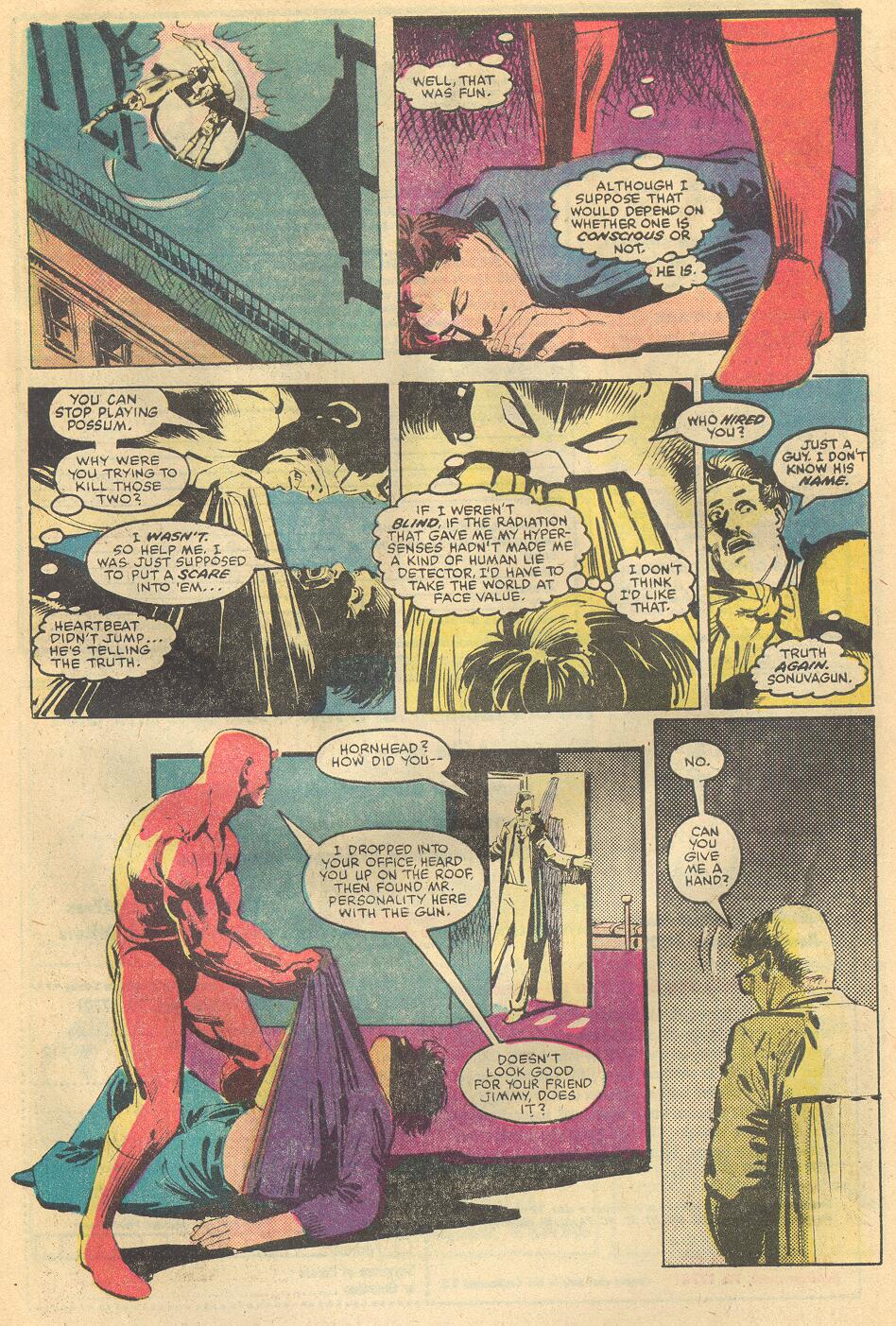 We cut to Ben's apartment, as his wife freaks out about roaches and life in their apartment, mostly alone, as Ben works... 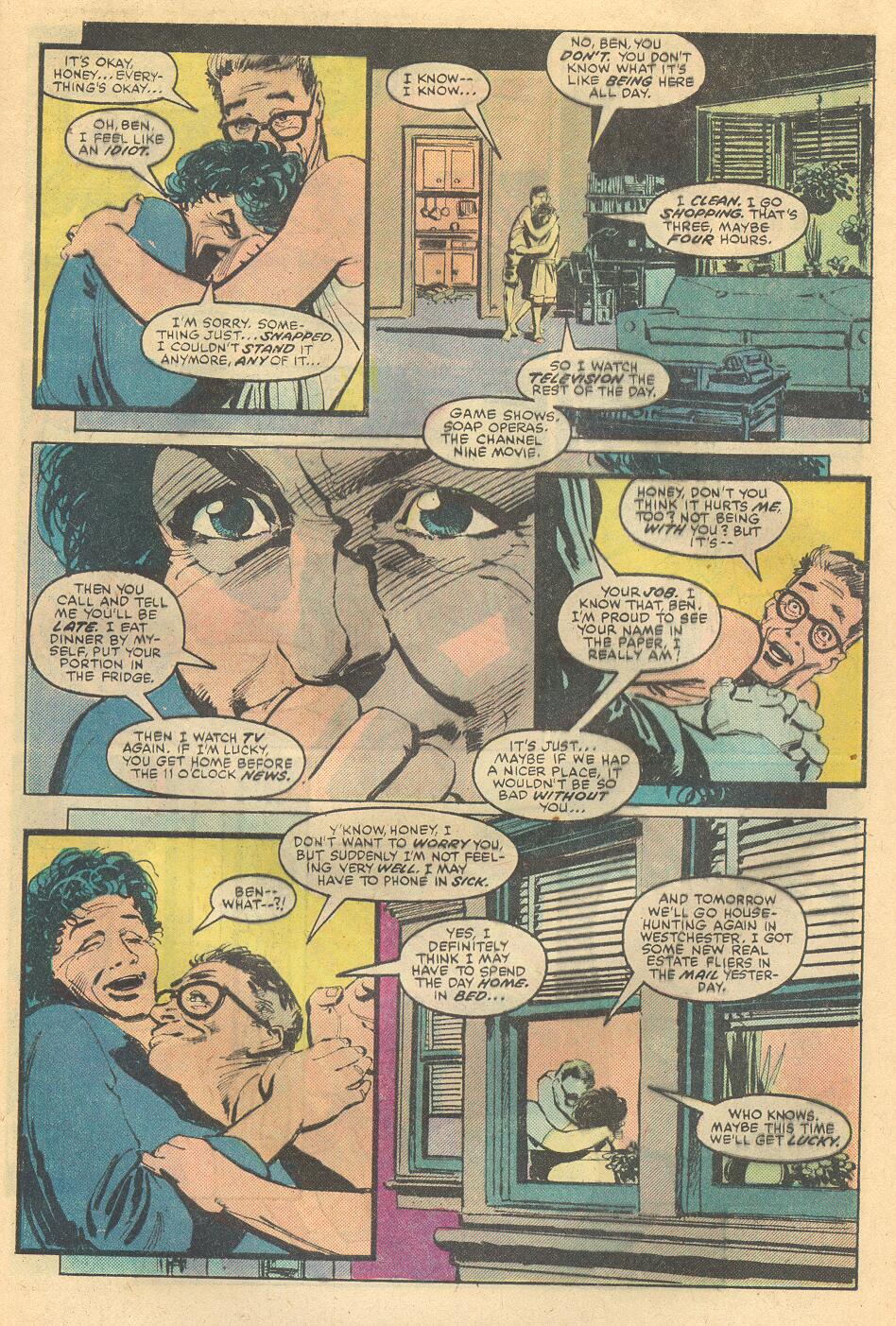 Ben comforts her and promises to go house hunting. DD goes to consult with the DA's office about accusations in the letters given to Urich, while ben and his wife look at a house in Westchester. It is more than they can afford for the down payment, yet the seller is anxious to unload the property and practically pleads for Ben to talk to his bank. DD tracks down a lead on a mob accountant, from the 60s, living in Jersey. He gets past guard dogs and security systems to find records of payments to a holding company, with the former editor named as thepresident of the company. He goes to tell Urich what he has found, coming in through the window, disturbing Ben's wife. Ben is angered to find confirmation, rather than exoneration. They are interrupted by a call from the house seller, who has cleared a loan from his bank for Ben to buy the house. he is elated and DD congratulates the couple, as he leaves. Ben goes out of the city to confront his old boss and hears the worst... 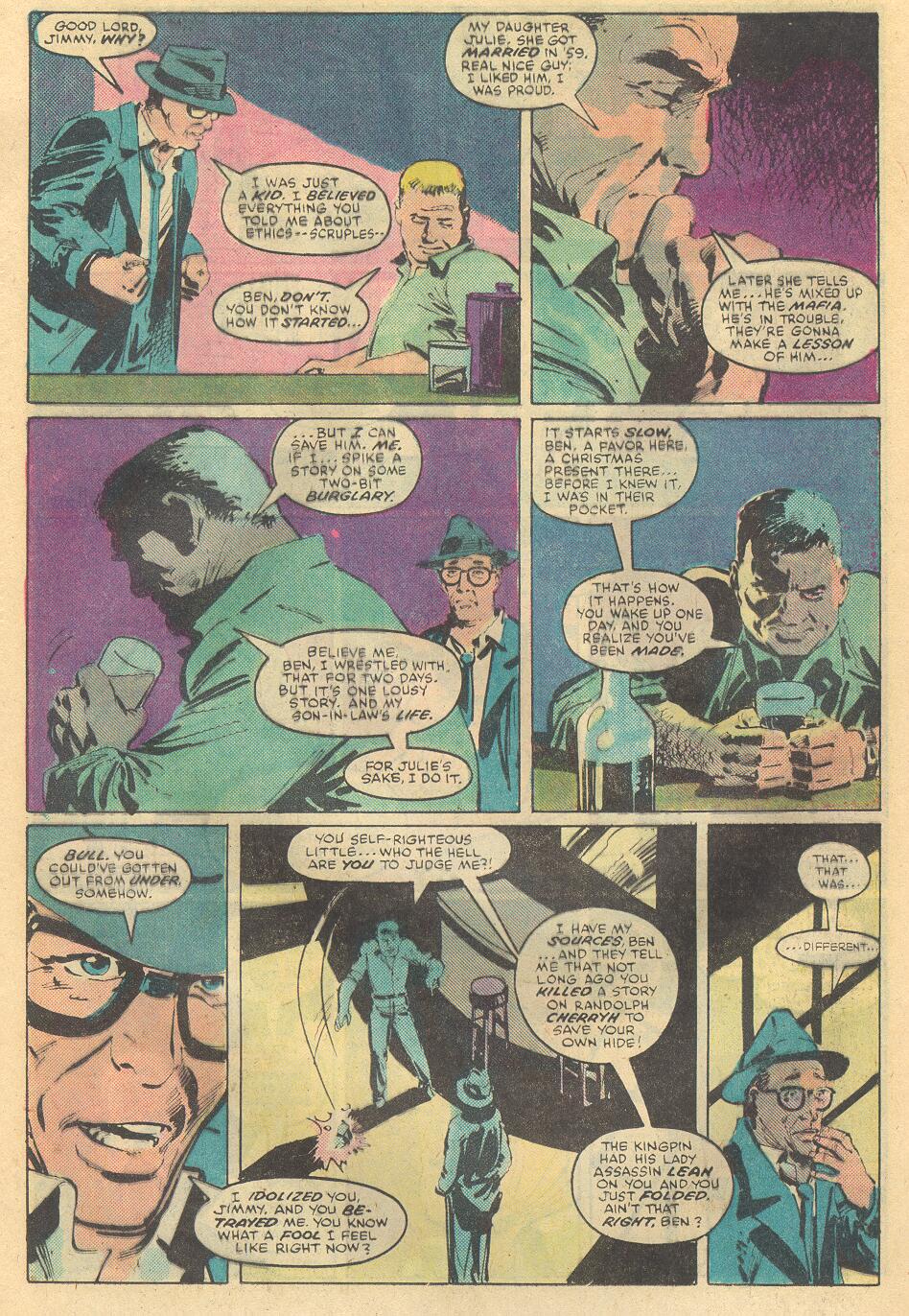 His mentor fires back about Ben tanking a story after a death threat from Elektra and questions whether Ben's anger is with him or himself. Matt Murdock shows up in his offices and asks Foggy about the seller of the house. Turns out, he is the brother of the late Masked Marauder, who owned several properties. He inherited after the Marauder's death. Matt knows he is on to something, unfortunately. He goes to a certain address, thrashes some hoods and bodyguards and confronts the Kingpin. 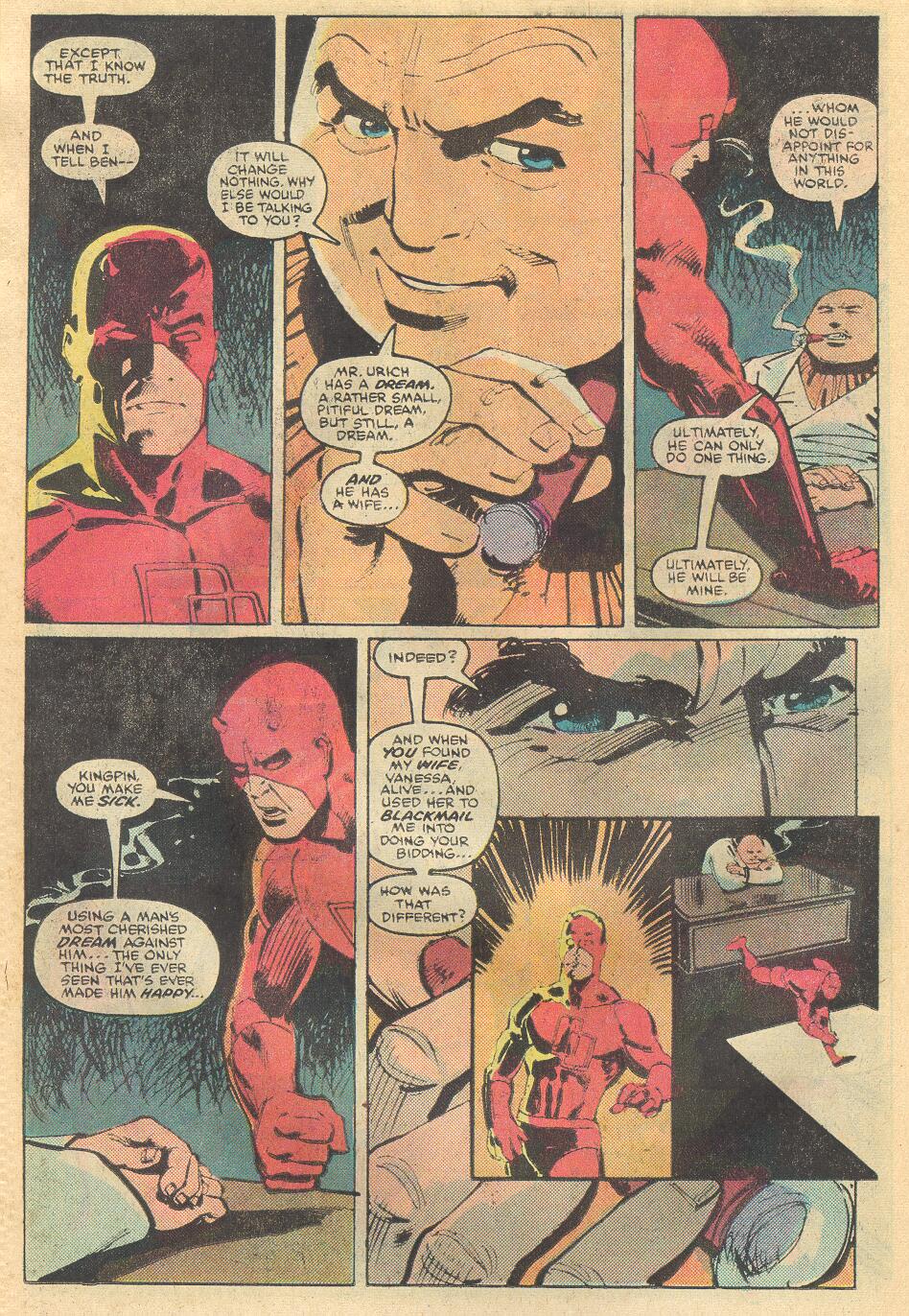 DD faces accusations of his own manipulations of loved ones, for his benefit and leaves. He gives the evidence to Ben and it leads to self pity and angry backlash... 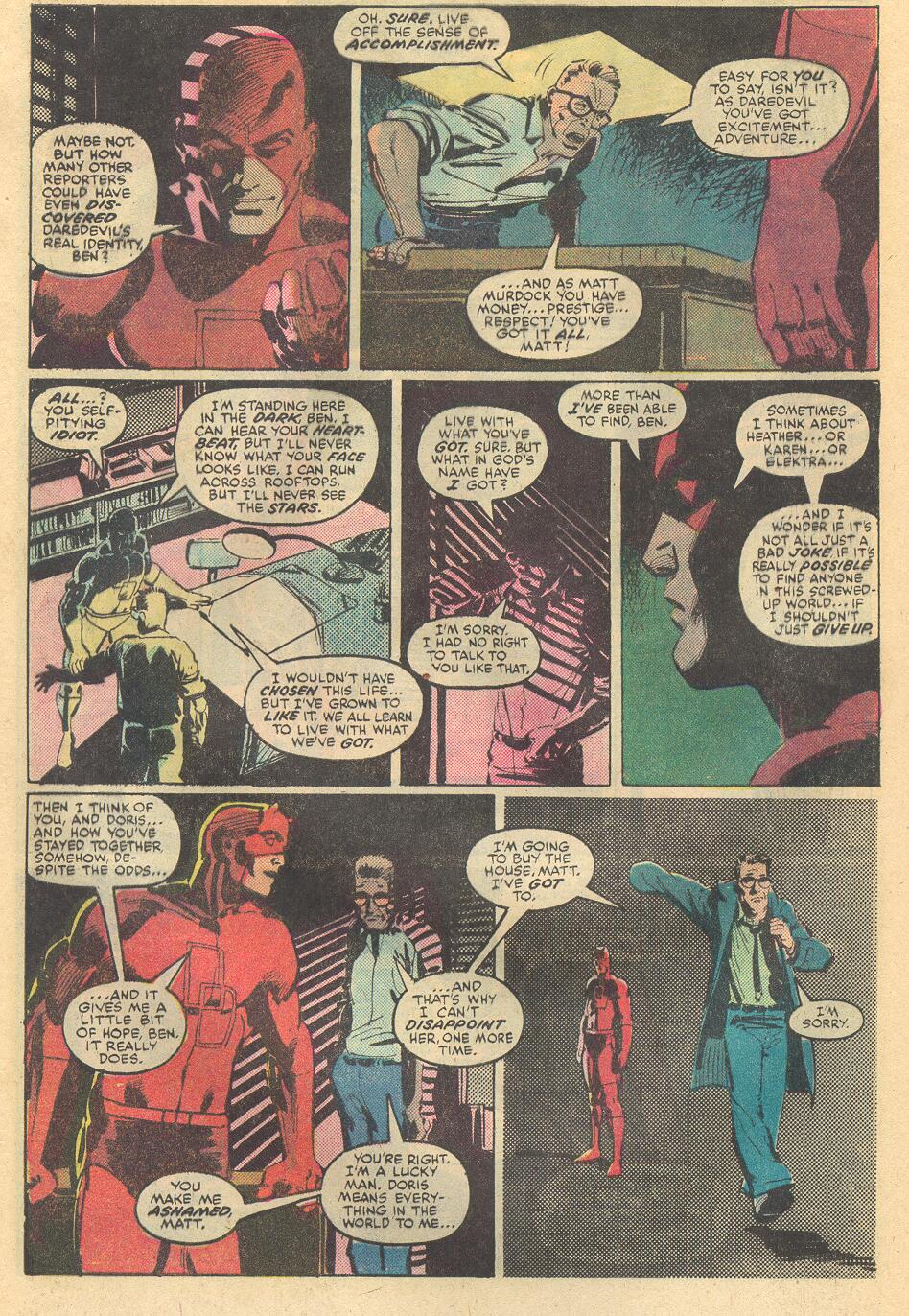 Ben goes out ot the remnants of Coney Island and thinks back about how he met his wife and contemplates what to do, until she shows up, after DD came looking for Ben and she forced him to tell her what was going on. Ben has decided to bury the story but she won't let him and Ben is reminded again of why he loves this woman more than his journalistic principles and his byline. Thoughts: This is not your typical DD story, though it does reflect what the book became under Miller, with O'Neil's guidance. Alan Brennert presents us a story of how we compromise our principles for the sake of others and how dangerous that is, when it is for the wrong reasons. Ben finds out a mentor was taking mob money and can't believe it, which sets off a chain of events that proves it. Meanwhile, Kingpin is manipulating his desires to give a better life and home to his wife into drawing him into his web, to silence his stories about Kingpin's operations. he stopped him once with a threat, but uses psychology, this time. It nearly works. Brennert deals in human frailties, as Ben's mentor made his first compromise to save a son-in-law, in trouble with the mob. One favor became two and three and more. Ben tries to take the high ground and is confronted with his own compromise. DD confronts Kingpin and is confronted with his own underhanded use of Kingpin's wife, Vanessa. We all have flaws in our personalities and character. Very few live in true black and white worlds. We make decisions based on the situation and live with those decisions, for good or ill. Rarely is there a perfect answer. Brennert is giving us real life, in a story that leaves behind any tale of Daredevil fighting the Hand, or the latest universe threatening being. He demonstrates his flair for getting to the hearts and minds of characters, making then think and act like real people, which makes them more relatable. We see the parallels to the structure of Batman, as DD enters and leaves via windows, consults law enforcement contacts, and takes out snipers who are decoys. We also see the more traditional writing style, as Brennert works from a script, which spends a bit of time explaining how DD is using his abilities to get past security systems. The rule is "show, don't tell" and Miller probably would have left the scene wordless. Brennert explains some of the subtleties. Excellent piece and Brennert's sole superhero story for Marvel, which could have easily dropped Daredevil and usedjust Matt Murdock or a private eye. Brennert leaves comics behind, again, as he is busy with the revived Twilight Zone. He would return to comics in 1989, to help celebrate a Batman milestone. That is our next subject.
|
|





















